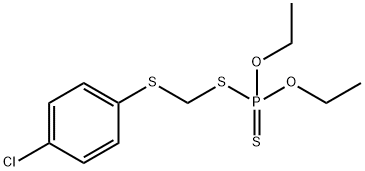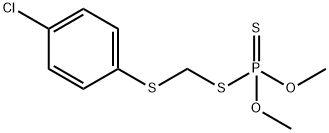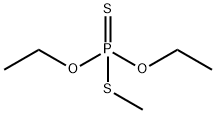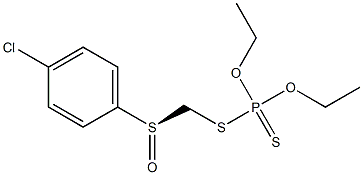CARBOPHENOTHION
Synonym(s):S-(4-Chlorophenylthiomethyl) O,O-diethyl phosphorodithioate
- CAS NO.:786-19-6
- Empirical Formula: C11H16ClO2PS3
- Molecular Weight: 342.87
- MDL number: MFCD00128009
- EINECS: 212-324-1
- SAFETY DATA SHEET (SDS)
- Update Date: 2024-03-14 15:18:26

What is CARBOPHENOTHION?
Description
Carbophenothion is an off-whiteto light-amber-coloured liquid with a mild mercaptanlike odour. It is slightly soluble in water and miscible with many organic solvents such as hydrocarbons, alcohols, ketones, and esters. The U.S. EPA has grouped it under RUP. Carbophenothion is used as a non-systemic insecticide and acaricide used for preharvest treatments on deciduous, citrus and small fruits, field crops, and vegetables and for the control of aphids, mites, suckers, and other pests on fruit, nuts, vegetables, sorghum, and maize.
Chemical properties
Carbophenothion is an off-white to light amber colored liquid with a mild mercaptanlike odor. It is slightly soluble in water, and miscible with many organic solvents, such as hydrocarbons, alcohols, ketones, and esters. The US EPA has classifi ed it as an RUP. Carbophenothion is used as a non-systemic insecticide and acaricide for pre-harvest treatments on deciduous, citrus and small fruits, fi eld crops, and vegetables, and for the control of aphids, mites, suckers, and other pests on fruit, nuts, vegetables, sorghum, and maize
Chemical properties
Carbophenothion is a colorless to light amber liquid with a characteristic odor.
The Uses of CARBOPHENOTHION
Carbophenothion is an organophosphorus pesticide used for fruits and vegetables.
The Uses of CARBOPHENOTHION
Miticide; insecticide.
The Uses of CARBOPHENOTHION
Nonsystemic insecticide and acaricide for controlling mites, aphids and other insects on deciduous fruit trees.
Definition
ChEBI: Carbophenothion is an organic sulfide.
General Description
An off-white to amber liquid with a mild odor of rotten eggs. Used as an insecticide and acaricide, primarily for citrus crops and deciduous fruits and nuts.
Air & Water Reactions
Insoluble in water.
Reactivity Profile
CARBOPHENOTHION is a halogenated organophosphate derivative. Organophosphates are susceptible to formation of highly toxic and flammable phosphine gas in the presence of strong reducing agents such as hydrides. Partial oxidation by oxidizing agents may result in the release of toxic phosphorus oxides.
Health Hazard
CARBOPHENOTHION is highly toxic; the estimated fatal oral dose is 0.6 g for a 150 lb. (70 kg) person. It is an indirect cholinesterase inhibitor, meaning its effects are on the nervous system.
Health Hazard
Carbophenothion is highly toxic through ingestion and skin absorption. Carbophenothion affects the nervous system by inhibiting ChE activity. On heating or burning, carbophenothion undergoes decomposition and produces toxic fumes such as phosphorus oxides, sulfur oxides, and hydrogen chloride. Exposures to carbophenothion cause poisoning with symptoms such as headache, blurred vision, weakness, nausea, discomfort in the chest, abdominal cramps, vomiting, diarrhea, salivation, sweating, and pinpoint pupils. It is highly toxic when eaten and nearly as toxic when absorbed through the skin. Large single doses of carbophenothion potentiate the toxicity of malathion
Health Hazard
Highly toxic cholinesterase inhibitor; exhibitsacute, delayed, and chronic poisoning; expo-sure risk of inhalation of vapors, however,may be low because of its very low vaporpressure [3.0 *10 -7 torr at 20 °C (68 °F)];also, severity of toxicity may vary widelyfrom species to species; rats are more vul-nerable to its effect than are mice or rabbits;signs of toxicity in human include headache,dizziness, muscle spasms, tearing, blurredvision, salivation, vomiting, abdominal pain,diarrhea, chest pain, and convulsions; highexposure can cause coma and death; inges-tion of 0.4–1 g can be lethal to adult humans.
LD50 oral (rat): in the range 7–10 mg/kg
LD50 skin (rat): 27 mg/kg.
Fire Hazard
(Non-Specific -- Organophosphorus Pesticide Liquid, n.o.s.) Container may explode in heat of fire. Fire and runoff from fire control water may produce irritating or poisonous gases.
Safety Profile
Poison by ingestion, skin contact, and intraperitoneal routes. Moderately toxic by subcutaneous route. Mutation data reported. A cholinesterase inhibitor. When heated to decomposition it emits very toxic fumes of SOx, POx, and Cl-. See also PARATHION, ESTERS, and MERCAPTANS.
Potential Exposure
Those engaged in the manufacture or application of this material, which is an insecticide and acaricide; primarily for citrus crops and deciduous fruits and nuts.
First aid
If this chemical gets into the eyes, remove anycontact lenses at once and irrigate immediately for at least15 min, occasionally lifting upper and lower lids. Seek medical attention immediately. If this chemical contacts theskin, remove contaminated clothing and wash immediatelywith soap and water. Speed in removing material from skinis of extreme importance. Shampoo hair promptly if contaminated. Seek medical attention immediately. If thischemical has been inhaled, remove from exposure, beginrescue breathing (using universal precautions, includingresuscitation mask) if breathing has stopped and CPR ifheart action has stopped. Transfer promptly to a medicalfacility. When this chemical has been swallowed, get medical attention. Give large quantities of water and inducevomiting. Do not make an unconscious person vomit
Environmental Fate
Soil. Though no products were reported, the half-life was reported to be ≥100 days
(Verschueren, 1983).
Chemical/Physical. Oxidizes to sulfoxide, sulfone, thiol, thiosulfone and thiosulfoxide
(Hartley and Kidd, 1987). Emits toxic fumes of chlorine, phosphorus and sulfur oxides
when heated to decomposition (Sax and Lewis, 1987).
storage
Color Code—Blue: Health Hazard/Poison: Storein a secure poison location. Prior to working with thischemical you should be trained on its proper handling andstorage. Store in tightly closed containers in a cool, wellventilated area
Shipping
UN3018 Organophosphorus pesticides, liquid, toxic, Hazard Class: 6.1; Labels: 6.1-Poisonous materials. UN 2783 Organophosphorus pesticides, solid, toxic, Hazard Class: 6.1; Labels: 6.1-Poisonous material.
Incompatibilities
The substance decomposes on heating or on burning, producing toxic fumes including phosphorus oxides, sulfur oxides, hydrogen chloride. Contact with oxidizers may cause the release of phosphorous oxides. Contact with strong reducing agents, such as hydrides; may cause the formation of flammable and toxic phosphine gas.
Waste Disposal
Hydrolysis by hypochlorites may be used, as may incineration, In accordance with 40CFR165, follow recommendations for the disposal of pesticides and pesticide containers. Must be disposed properly by following package label directions or by contactingyour local or federal environmental control agency, or by contacting your regional EPA office.
Properties of CARBOPHENOTHION
| Melting point: | 25°C |
| Boiling point: | bp0.01 82° |
| Density | 1.32 |
| refractive index | 1.6198 |
| Flash point: | -18 °C |
| storage temp. | APPROX 4°C
|
| solubility | DMSO (Slightly), Ethyl Acetate (Slightly) |
| form | neat |
| Water Solubility | 630.2ug/L(20 ºC) |
| Merck | 13,1831 |
| BRN | 1885240 |
| EPA Substance Registry System | Carbophenothion (786-19-6) |
Safety information for CARBOPHENOTHION
| Signal word | Danger |
| Pictogram(s) |
 Skull and Crossbones Acute Toxicity GHS06  Environment GHS09 |
| GHS Hazard Statements |
H300:Acute toxicity,oral H311:Acute toxicity,dermal H410:Hazardous to the aquatic environment, long-term hazard |
| Precautionary Statement Codes |
P264:Wash hands thoroughly after handling. P264:Wash skin thouroughly after handling. P270:Do not eat, drink or smoke when using this product. P273:Avoid release to the environment. P280:Wear protective gloves/protective clothing/eye protection/face protection. P301+P310:IF SWALLOWED: Immediately call a POISON CENTER or doctor/physician. |
Computed Descriptors for CARBOPHENOTHION
New Products
4-AMINO-TETRAHYDRO-PYRAN-4-CARBOXYLIC ACID HCL 4-(Dimethylamino)tetrahydro-2H-pyran-4-carbonitrile 4-Aminotetrahydropyran-4-carbonitrile Hydrochloride (R)-3-Aminobutanenitrile Hydrochloride 3-((Dimethylamino)methyl)-5-methylhexan-2-one oxalate 1,4-Dioxa-8-azaspiro[4.5]decane 5-Bromo-2-nitropyridine Nimesulide BP Aceclofenac IP/BP/EP Diclofenac Sodium IP/BP/EP/USP Mefenamic Acid IP/BP/EP/USP Ornidazole IP Diclofenac Potassium THOMAIND PAPER PH 2.0 TO 4.5 1 BOX BUFFER CAPSULE PH 9.2 - 10 CAP SODIUM CHLORIDE 0.1N CVS ALLOXAN MONOHYDRATE 98% PLATINUM 0.5% ON 3 MM ALUMINA PELLETS (TYPE 73) LITHIUM AAS SOLUTION 2-Bromo-1-(bromomethyl)-3-chloro-5-nitrobenzene 2-Bromo-3-nitroaniline N-(3-Hydroxypropyl)-N-methylacetamide 3-Bromo-6-chloropyridazine 4-ethyl-3-nitrobenzoic acidRelated products of tetrahydrofuran







![CARBOPHENOTHION METHYL-O-ANALOG 50MG [R]](https://img.chemicalbook.in/)
You may like
-
 Carbophenothion CAS 786-19-6View Details
Carbophenothion CAS 786-19-6View Details
786-19-6 -
 1-Methyl-6-oxo-1,6-dihydropyridazine-3-carbonitrile 98%View Details
1-Methyl-6-oxo-1,6-dihydropyridazine-3-carbonitrile 98%View Details
99903-60-3 -
 1823368-42-8 98%View Details
1823368-42-8 98%View Details
1823368-42-8 -
 2-(3-(tert-butyl)phenoxy)-2-methylpropanoic acid 1307449-08-6 98%View Details
2-(3-(tert-butyl)phenoxy)-2-methylpropanoic acid 1307449-08-6 98%View Details
1307449-08-6 -
 Ethyl 3-(furan-2-yl)-3-hydroxypropanoate 25408-95-1 98%View Details
Ethyl 3-(furan-2-yl)-3-hydroxypropanoate 25408-95-1 98%View Details
25408-95-1 -
 2-Chloro-5-fluoro-1-methoxy-3-methylbenzene 98%View Details
2-Chloro-5-fluoro-1-methoxy-3-methylbenzene 98%View Details
1805639-70-6 -
 1784294-80-9 98%View Details
1784294-80-9 98%View Details
1784294-80-9 -
 Lithium ClavulanateView Details
Lithium ClavulanateView Details
61177-44-4